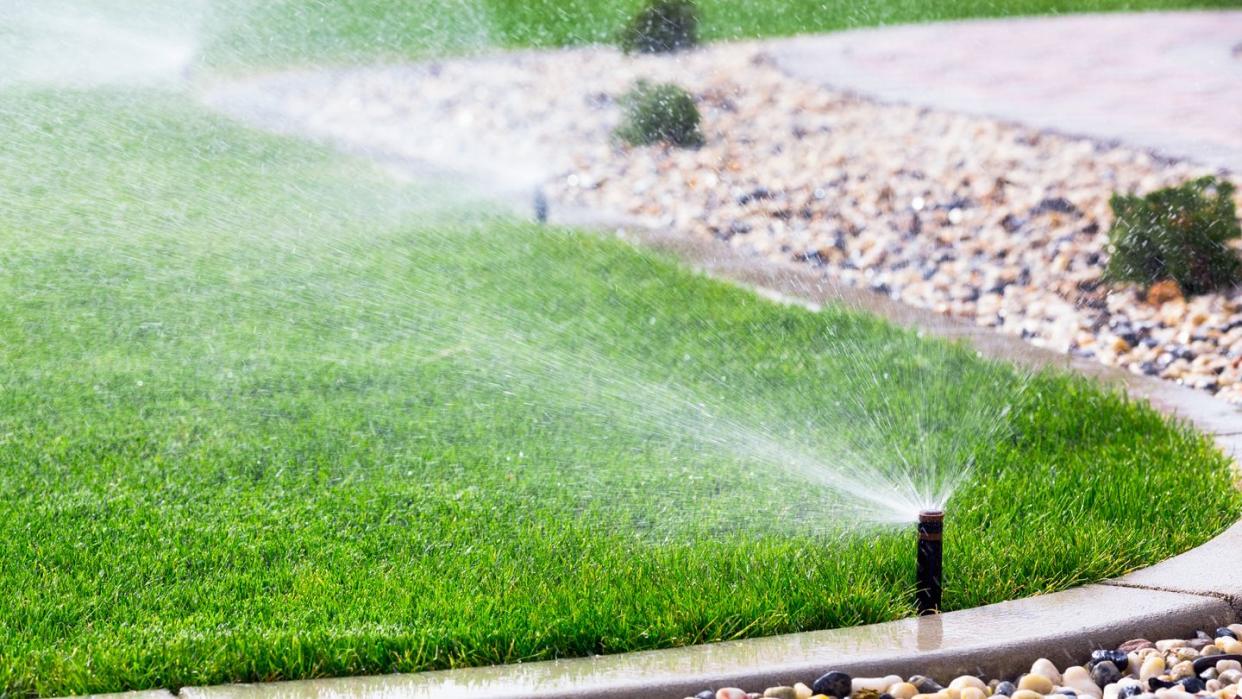Don't Put Off Winterizing Your Lawn Sprinklers

When preparing for winter, you prune back your perennials, cover your swimming pool, rake fallen leaves, and abandon your citronella candles in favor of pumpkin spice. But throughout the hustle and bustle of winter preparation, there's one thing you never want to forget: blowing out your sprinkler system. If you have in-ground irrigation, the process of blowing out or winterizing your sprinkler system prevents sitting water from freezing and damaging your pipes.
To give us the low-down on this must-do winter chore, we spoke to Shane Dyer, CEO of the digital irrigation company Irrigreen, whose sprinkler heads are designed to cut back water usage and cover landscaping more efficiently. "Odds are you're not using your sprinklers during the winter," he says. "And all that excess water is doing more harm than good by sitting there."
Exactly how to winterize sprinklers depends on your irrigation system. "To winterize the Irrigreen system, you just press a button on the companion app," Dyer says. "But it's important to know how to blow out your sprinklers manually just in case." Read on to learn why you should always winterize your sprinkler system, the right way to do it, and what it typically costs to have a pro do it for you.
Why Is It Important to Winterize Sprinklers?
Unlike nearly every other molecule that condenses when it freezes, water expands. When the water that's sitting in your pipes turns into ice, it can crack the pipes and sprinkler heads. In order to protect your expensive sprinkler system during the off-season, you should remove as much water as possible to limit the possibility of damage.
How to Blow Out Lawn Sprinklers
For traditional sprinkler heads, you'll want to locate your valve box and have an air compressor on hand. If you have digital sprinklers like the Irrigreen ones, you can easily blow them out via the companion app.
Step One: Shut Off the Water
Turn off all water to the system and drain the remaining water. This ensures that no additional water will flow into the pipes. If your sprinklers operate on a timer, turn it off or shut it down for the season.
Step Two: Set Up the Air
Attach the air compressor to your irrigation system and close off the airflow valves on the compressor, then begin to blow air into the pipes.
Step Three: Blow Out the Water
Starting with the farthest zone and working your way in, close the back flow valves on your irrigation system and turn on the air compressor. Be sure to keep an eye on air pressure and gradually increase until you reach the recommended PSI for your system. Once the water flow stops, move onto the next zone immediately.
Step Four: Release the Pressure
Once you've finished pushing air through the entire system, open and close the back flow valves a few times to release any pent-up air.
How Much Does It Cost to Blow Out Sprinklers?
If you opt to hire a professional rather than DIY the winterizing process, we don't blame you. According to Home Advisor, the average cost of hiring a landscaper to blow out your sprinkler system for you is $75 to $200, depending on how large your yard is and how many sprinkler heads there are.
Does Everyone Need to Blow Out Their Sprinklers?
No! According to Dyer, if you don't typically protect any other plumbing for the winter, you probably don't need to protect your sprinkler system. And while climates are changing these days, drought-prone areas and those with typically mild or even warm winters don't need to worry about winterizing sprinkler systems (think the Southwest, Southern California, and Florida). "These areas will often have surface frost, but the cold won't penetrate the ground deep enough (more than a foot deep), to become a problem," he says.
You Might Also Like

